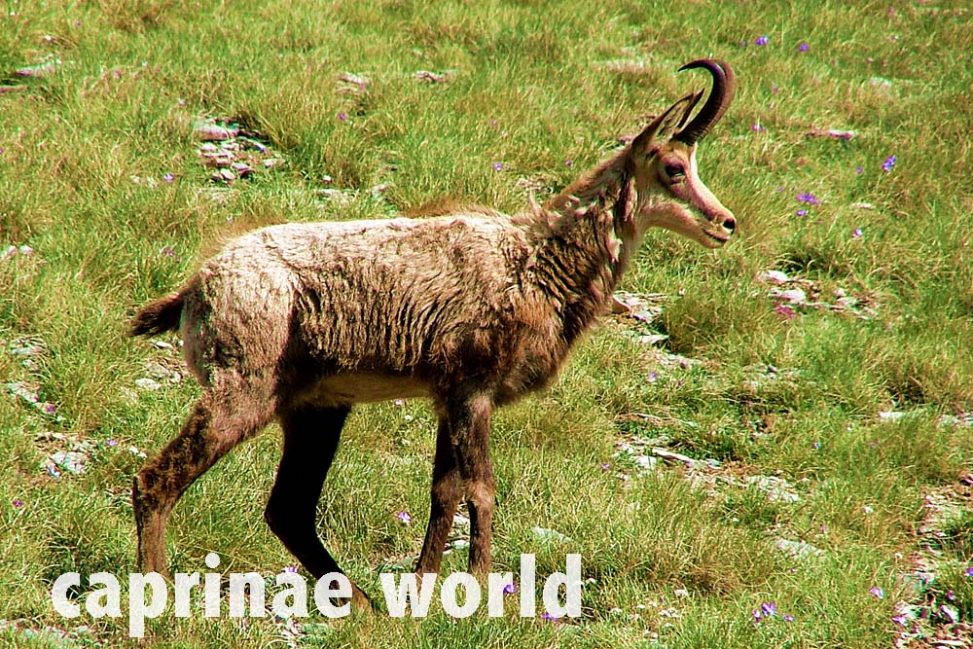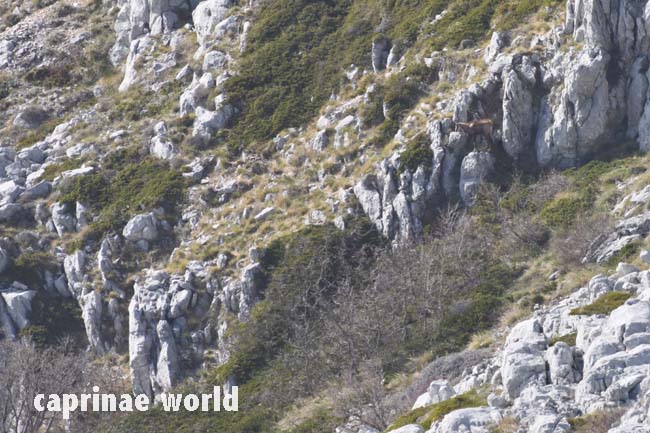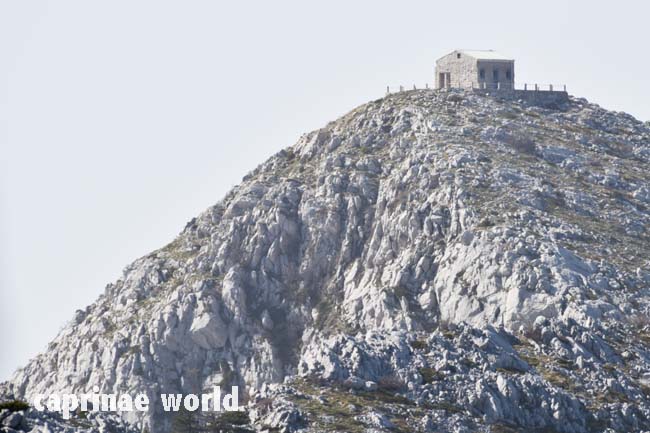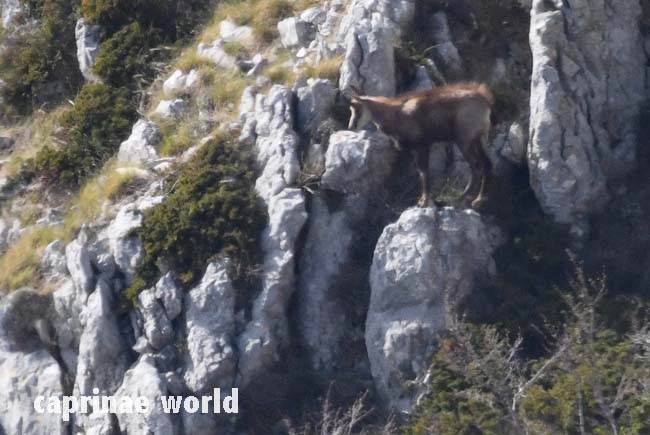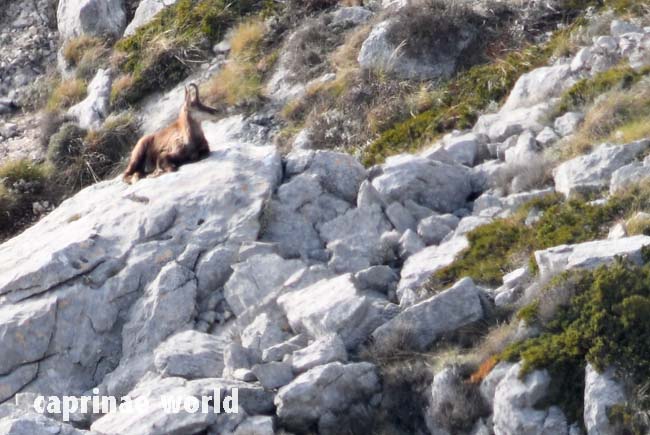The Balkan Chamois is a subspecies of the Alpine Chamois. In the former Yugoslav countries it is slowly recovering from the civil war (1991 to 2001).
Names
Albanian: Dhija, egér [2], dhia e egër [3, 12]
Bulgarian: Diwa kosa [2], diwa kosa [3]
Chech: Kamizici zver [2]
Croatian: Divokoza [2]
English: Balkan Chamois [2, 3]
French: Chamois des balkans [2]; Chamois du Balkan [3]
German: Balkangams [3]; Balkangemse [2] ((editor’s note: old spelling rule; not in use any more))
Greek: Agriogido [2], agriógido, -yido [3]
North Macedonian: divokoza [3]
Montenegrin: Dovikoza [2]
Russian: Балканская серна [3, wikipedia]
Serb: Divokoza [2], divokoza [3]
Spanish: Rebeco de los Balcanes [2]; Rebeco balcanico [2]
Other (putative) scientific names and synonyms:
Rupicapra rupicapra olympica, Koller 1929
Taxonomy
Rupicapra rupicapra balcanica
Bolkay, 1925 [3]
Karyotype: 2n = 58 [3]
Many authors consider the Balkan Chamois (Rupicapra rupicapra balcanica) a subspecies of the Alpine Chamois (Rupicapra rupicapra). But there are also doubts. Groves and Grubb (2011) write: „Evidence as to the distinctiveness of this taxon is lacking, and more specimens need to be studied.“ [5]
The split between Alpine and Balkan Chamois is of relatively recent origin, probably occurring around the last glacial period some 10.000 to 12.000 years ago. [3]
The taxonomic status of Chamois on the Balkan peninsula, is uncertain. As many as three subspecies have been described and recognised (R. r. rupicapra; R. r. balcanica and R. r. olympica) – (Bolkay 1925; Djulić and Mirić 1967; Koller 1929; Martino 1934; Mirić 1970). The latter subspecies is now accepted as a consubspecific of the Balkan Chamois (Ellerman and Morrison Scott 1966; Lovari 1987; Masini and Lovari 1988; Sägesser and Krapp 1986). Balkan and Alpine Chamois are currently separated on the basis of difference in maxillary tooth row (upper jaw bone) and horn characteristics, however, the exact diagnostic characteristics of Balkan Chamois need to be determined. [12]
Similar species/subspecies
The Balkan Chamois is said to be somewhat larger (probably [3]) than the Alpine Chamois, with longer horns, and lighter in colour. [2 – no indication of source!] The pelage during summer is supposed to be more brownish than the nominate form. [3] But it has also been mentioned that there is no certain way to distinguish the Alpine form the Balkan subspecies using external features. [3]
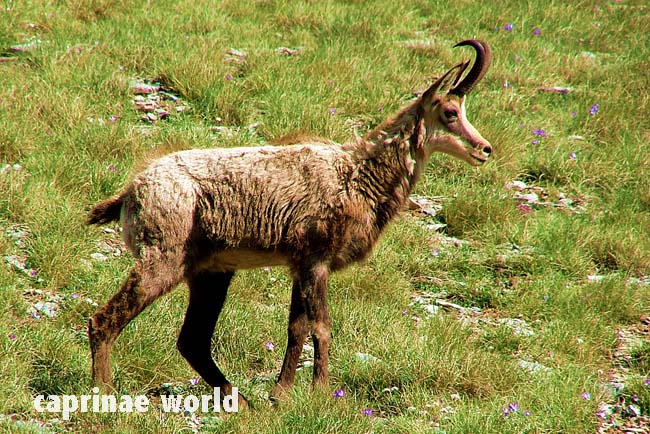
Balkan Chamois male. Photo: Alexandros Gassios, Mount Olympus, at 2.700 m asl, site code, GR1250001, 2005-06-30
Distribution
by country: Albania, Bulgaria, Greece, Former Yugoslavia (Bosnia and Herzegovina, Croatia, Kosovo, North Macedonia, Montenegro, Serbia) [12, 3]
In general populations of Balkan Chamois are fragmented throughout the distribution range and in many cases isolated from each other. [3] On the other hand due to numerous re-introductions and introductions over the last decades, the Balkan Chamois has also entered its distribution into areas it was not present before World War II. [12]
In Albania Balkan Chamois inhabit most of the mountain regions. In the north in occurs in the Alps of Albania (Shkodrë, Tropojë, and Kukës). In the eastern regions they are known to occur in the Dibra Highlands, the Librazhd region, Pukë, Mirditë and Mat [12]; furthermore in the district Gjirokastra, which borders Greece. [3] In the central region they inhabit Barat and Skrapar; and in the south and southeast, Kolonjë and Përmett. [12]
In Bosnia and Herzegovina Balkan Chamois occur in Cvrsnica, Prenj, Velež, Bjelašnica, Treskavica, Zelengora, Bjelasnica and Sušica (in Drina Canyon) (Rapaić et al. 2007). [3]
In Bulgaria it is found generally above 1.000 metres asl throughout the northern Rila and Pirin Mountains, in the central Balkan Mountains, and in some areas of the Western Rhodopes. Alpine Chamois (R. r. rupicapra) have been introduced in some areas. [12]
In Croatia the introduced Chamois on the Croatian Adriatic Coast between Senj and Makaraka ((editor’s note: misspelling – Makarska)) are of unknown genetic origin, and are possibly Alpine/Balkan hybrids. [3]
Chamois from Velebit, Jabalanc, Biokovo and Makarska ((editor’s note: Biokovo (mountain range) and Makarska (nearest city) can be seen as synonyms)) have been entered as Balkan Chamois in certain hunting-trophy recording systems. Chamois from the Gorski kotar are considered Alpine Chamois. [3]
In Greece the current distribution of Balkan Chamois includes 18 distinct sub-populations on the following mountains: Northern and Central Pindus, Eastern and Central Rhodope, Central Sterea Ellada, Mount Olympus, Mount Tzena-Pinovo and Mount Nemertsika (Papaioannou, in Apollonio et al. 2010). [3]
In 1991 the distribution range for Greece was described as follows: Balkan Chamois is currently restricted to 11 mountains, and comprising at least six distinct and widely scattered population groups from Mount Rodopi in the northeast below the Bulgarian border, and from the Epirus Mountains in the Northwest, to Mount Giona in Central Greece. Balkan Chamois was believed extinct around Mount Varnous in Northern Greece (Hatzirvassanis 1991), but recent reports suggest that some animals may still use the area seasonally, moving in from Mount Pelister in neighbouring North Macedonia. Similarly, small numbers sometimes enter Greece from Albania around mount Nemertsika (Papaioannou 1991). [12]
In Kosovo they are said to occur in Šar Planina National Park and Prokletija (Albanian Alps). [3]
In North Macedonia the major Chamois concentrations are located in the complex mountain systems of western and central North Macedonia (Karadzica, Jablanica, Galichica, Bistra, Korab, Šar and Pelister Mountains). There is another nucleus of Balkan Chamois in the Kozhuf Mountains which straddle the border with Greece in the south. [3]
In Montenegro, the major, mostly transboundary, Balkan Chamois populations occur on Durmitor Mountain, in the Tara Canyon, Prokletije Mountains and on Komovi Mountain. There are also a couple of small herds of no more than 10 animals on Orjen and Hajla Mountains. [3]
In Serbia the only native Balkan Chamois population persists in Tara National Park. Introduced populations occur in Djerdap National Park (northeastern Serbia, along the Rumanian border) and Zlot (eastern Serbia, near the town of Bor). [3]
General discription
The first historic evidence of Balkan Chamois comes from Xenophon (about 430 to 354 BC) a Greek historian, soldier and philosopher and contemporary of Socrates, who wrote in Kynegetikos and Anabasis that the Thracians, whom he encountered on his voyages, were hunting Chamois. [3]
size: probably somewhat larger than the Alpine subspecies [3]
Coloration / pelage
overall body colour in summer: more brownish than Alpine subspecies [3]
overall body colour in winter: dark hair with yellowish tint [3]
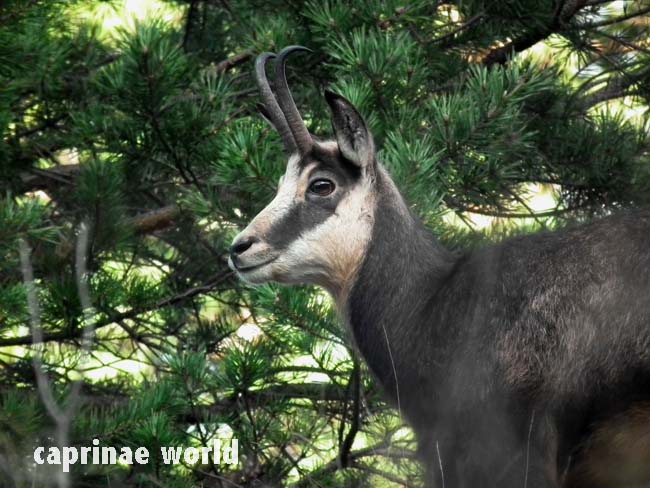
Balkan Chamois female in winter coat. Note the yellowish tint in the pelage on back and shoulders. Photo: Alexandros Gassios, Rhodope Mountains, Drama prefecture, North from Thessaloniki, near the Greek-Bulgarian border, protected area (natura 2000 site; code GR1140001)
limbs and brisket: darker than flanks and neck [3]
dorsal stripe: strongly developed; dark; from the occiput down to the root of the tail [3]
head: contrasting dark face mask; colour of the lower part of the jaws is only slightly lighter than the rest of the body pelage. [3]
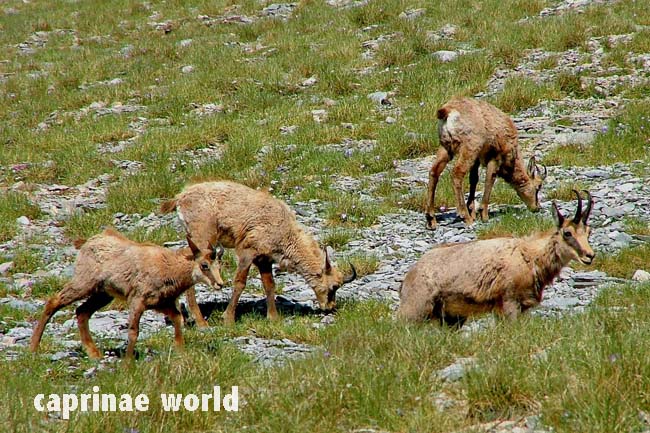
Balkan Chamois female and yearlings in pale summer coat. Photo: Alexandros Gassios, Mount Olympus, at 2.700 m asl, site code, GR1250001, 2005-06-30
Horns
The CIC database of this subspecies is incomplete:
mean (n=28): 111,8 CIC points; highest: 122,3; lowest: 103,6 [3]
longest horns CIC (mean; n=18): 27,2 cm; longest: 29,8 cm [3]
location of the two CIC top scoring trophies: Bosnia-Herzegovina, 1965 [3]
longest horn SCI: 30,5 cm [3]
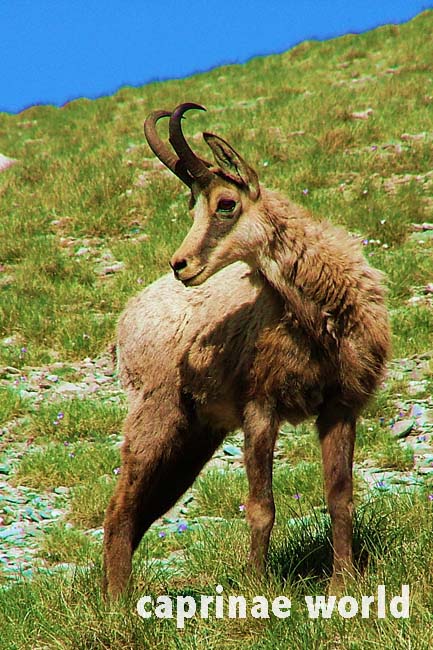
Balkan Chamois male with impressive set of horns. Photo: Alexandros Gassios, Mount Olympus, at 2.700 m asl, site code, GR1250001, 2005-06-30
Habitat
In Bosnia and Herzegovina it ranges between 120 and 2.385 metres asl, and in the Drina River Canyon (border of Bosnia and Herzegovina with Serbia) it lives between 230 and 900 metres asl. It is also found in the dry, karst limestone range of Dalmatia (encompassing the northern part of present-day Albania, much of Croatia, Bosnia and Herzegonvina, Montenegro, Kosovo and Serbia). [12]
In Bulgaria, in the Rila and Pirin Ranges, its principal habitats are the sub-alpine and alpine zones with manmade grasslands, rocky areas, shrublands of Mugo Pine (Pinus mugo) and Juniper (Juniperus sibirica), as well as the coniferous and Beech (Fagus sylvatica) forests. In the Balkan Mountains, it occurs in the subalpine zone, again comprised of natural and man-made grasslands, rocky areas, Juniper shrublands, and beech and coniferous (Picea abies, Abies alba) forests. By contrast, the chamois in Rhodope is entirely a forest dweller. [12]
Typical Chamois habitat in Greece is a forested valley with steep slopes extending to the alpine zone, and including cliffs and rock outcrops. [12]
Predators
Wolf (Canis lupus), Brown Bear (Ursus arctos), Golden Eagle (Aquila chysaëtos), Feral dogs (Canis familiaris) [12]
Status
The total population of Balkan Chamois is estimated to be between 14.000 and over 17.000. [3]
In Albania current (2013) population figures are probably only between 300 and 330 in total. [3]
In 1990 the total was still believed to be around 1.050 individuals. At that time densities varied from 0.03 animals/km² in Tomorr, to 1.6/km² in Kastriot Sllovë of Dibra. [12]
In Bosnia-Herzegovina today a maximum of about 1.000 individuals remain, distributed over many small and fragmented populations (Rapaić, in PIU Forestry and Agriculture 2007). [3]
Most populations have shrunk seriously with and after the civil war. However there is still plenty of suitable habitat for Chamois, which according to evaluations made by Rapaić et. al (2007) could sustain at least between 9.000 and 10.000 Balkan Chamois. Before 1990, the number of Chamois on the territory of Bosnia and Herzegovina was probably ca. 20 to 30 per cent under habitat capacity. [3]
In Bulgaria the total number of Chamois in 1988 (censused at the end of winter) was between 1.560 and 1.630. Separate population estimates were available for each of the main massifs: Pirin: 400 to 420; Rila: 590 to 620; Balkans: 200 to 220; and Rhodopi: 370 to 390. Populations are either stable or increasing slowly (Genov and Massei 1989). [12]
The estimates are not significantly different from the 1.700 reported by Genov et al. (1990), because the sources of information were the same. Actually, some differences are the result of duplication in cases where two or more administrative units reported figures for the same area. [12]
By 1965, the numbers of Balkan Chamois in Bulgaria started to increase steadily. In the 1980s population numbers exceeded the carrying capacity of available habitat. The political change and lack of control in the 1990s led to a considerable increase in poaching and probably halved the numbers again. With the establishment of the Bulgarian National Park Directorate, Balkan Chamois started a slow recovery coupled with some range expansion. [3]
In Greece the total population is estimated at between 480 and 750 individuals (Papaioannou & Kati 2007). The size of the sub-populations ranges from 10 to 130 individuals. Introductions have never been attempted and consequently the genetics of Greek R. r. balcanica appear to be pure (Papaioannou, in Apollonio et al. 2010). [3]
In 1997 the total population was estimated to be no more than 500 individuals and believed to be decreasing, consequently the species was classed as Endangered in this country. [12]
Kosovo: Šar Planina National Park has approximately 450 individuals and Prokletije 150. [3]
Montenegro: Durmitor Mountain has ca. 300 animals; Tara Canyon ca. 150 animals, Prokletije Mountains ca. 100 animals and Komovi Mountain ca. 100 animals. There are also a couple of small herds of no more than 10 animals on Orjen and Hajla Mountains. [3]
In North Macedonia the total number of Balkan Chamois was put in 2011 to 3.500 individuals. Numbers in Manrovo National Park alone are estimated to be between 1.200 and 2.000 individuals. [3]
Serbia: According to official statistics the total current population is 600 individuals (Djerdap National Park: 100 animals – down from about 250 in early 1990s; Canyon of Zlot: about 200 animals; Tara National Park: about 200 animals – down from 300 during Yugoslav times) [3]
Major threats
In Albania, habitat loss is a major threat in some regions due to land demands from expanding human populations. There appears to be no competition from domestic livestock. Poaching does occur but the extent is not known. [1]
In Bulgaria, the major threat is hybridization with Alpine chamois. In Rhodope this is almost complete, and is also a potential danger at Rila. The Balkan population which has been isolated for about 100 years is still small and vulnerable, and poaching has not yet been eliminated. The majority of the populations in Rila and Pirin are not directly threatened, but neighbouring populations are potentially threatened by hybridization. Outside the protected areas, poaching remains a problem. [1]
In Greece, poaching facilitated by road developments, and predation by feral dogs are the main threats to chamois survival (Hatzirvassanis, 1991). Another serious threat is domestic livestock grazing which creates ecological competition and habitat loss, and all three threats occur both within and outside national parks (Hatzirvassanis, 1991; Tsunis, 1988). Forestry and tourist developments are the main causes of increased road construction, which in turn creates access for poachers. In some areas, recreation activities may significantly disturb Chamois (Adamakopoulos, in prep.). [1]
Former Yugoslavia: Although the subspecies is not threatened overall, there are several small isolated populations that are vulnerable to poaching and other disturbance factors (e. g. habitat degradation, competition from livestock, etc.). Sarcoptic mange has not been reported in this subspecies. Since 1991, the entire population of Balkan Chamois in Bosnia and Herzegovina was endangered because of military operations in many of the areas populated by this subspecies. In addition, a great number of firearms are in civilian hands in many other areas inhabited by Balkan Chamois outside of Bosnia and Herzegovina. [12]
Conservation
In Albania the Balkan Chamois was listed as Lower Risk in the 1996 IUCN Red List of Threatened Animals (IUCN, 1996). Balkan Chamois is protected under Law No. 3150 and can be hunted or captured only with special permission from the General Directorate of Forest Economy. It occurs in three protected areas in Albania: Thethi and Lura National Parks, and in Kuterman Nature Reserve. [12]
Bulgaria stands unique amongst the Balkan Chamois-range states in having elaborated an „Action Plan for the Balkan Chamois in Bulgaria 2007-2016“ with specific defined processes and objectives which include:
– the restoration and conservation of habitats;
– guidelines for sustainable use and management;
– maintaining the genetic purity of Balkan Chamois (The plan suggests that radical Alpin-chamois culling programs be used to limit and eventually eliminate hybridization.)
– providing effective genetic exchange between Balkan Chamois (sub)populations and
– an increase in numbers to at least 5.000 animals within 10 years (Valchev et al. 2006). – creating transboundary cooperation and joint management plans with the conservation authorities of the states bordering Bulgaria …
– including the reintroduction of Balkan Chamois in border areas [3]
History: In Bulgaria protection measures were first taken for native Balkan Chamois after the restoration of the Bulgarian State in 1878. Thanks to the actions of the Forestry Administration and sportsmen, Balkan Chamois still survives today. The Bulgarian Academy of Sciences has also played a major role in the conservation and increase of the subspecies since 1978. It is the least threatened species listed in the Bulgarian Red Book (1985), and it receives almost full protection. It has been gradually increasing in numbers since at least 1955 (Genov and Massei 1989). A total of seven populations are well distributed throughout the country helping ensure its survival. Despite protection, a small number of foreign hunters are allowed to shoot some animals each year. If current trends continue, it is projected that by the end of the 20th century, numbers may increase to >2.500 in protected areas. The Nature Protection Act (Decree No. 18833, 1962) protects 43 species of mammals including the Balkan Chamois. Game management is the legal responsibility of the Forestry Committee. Today, Balkan Chamois occur in 14 protected areas in Bulgaria. [12]
In Greece the Balkan Chamois is fully protected by law. Approximately 60 per cent of all Balkan Chamois in Greece occur in at least 17 protected areas, although their effectiveness is limited. [12]
Former Yugoslavia: Introductions and re-introductions have been an integral part of Chamois management. Alpine Chamois introductions were attempted in the northwest Dinaric Alps as early as 1872, either to improve existing herds or to create new ones. Between 1963 and 1987, 256 Balkan Chamois, mostly from Sutjeska National Park have been successfully introduced or reintroduced into 13 areas in Croatia, Bosnia and Herzegovina, and Serbia. By 1989-90, their numbers had increased to just over 2.500 animals. Not all introductions were successful, for example, the animals moved to Stolovi in Central Serbia were quickly eliminated by poachers. Until 1908, an autochthonous population of Chamois (subspecies not determined) occurred in the Velebit Mountains (Croatia). Following their extermination, several attempts were made to reintroduce Chamois starting before 1941. Two introductions (1974 and 1978) were successful but included both Balkan and Alpine Chamois, consequently the current (1992) population of 50 animals are hybrids. [12]
Table1 : Protected areas with Balkan Chamois [12]
| Country | area name |
| Albania |
Thethi NP (4.500 ha; est. 1966) Lura NP (4.000 ha; est. 1966) Kuturman (Senisht Qerret Mirake) Nature Reserve (4.000 ha; est. 1966) |
| Bosnia-Herzegovina | Sutjeska (17.250 ha; est. 1965) |
| Bulgaria |
Pirin National Park (40.000 ha; est. 1952); World Heritage Site 1983 Rila Monastery Forest Reserve (3.446 ha; est. 1986; buffer zone of 2.402 ha) Urdini ézéra (1.150 ha; est. 1985) Goliam Skakavets (4.180 ha; est. 1985) Marinchini ézéra (1.509 ha; est. 1951); Biosphere Reserve 1977) Ibâr (1.701 ha; est. 1985; buffer zone of 700 ha) Dubkata (1.211 ha; est. 1956), buffer zone 656 ha; Biosphere Reserve 1977) Kupéna (1.084 ha; buffer zone of 1.359 ha; Biosphere Reserve 1977) Sténéto (3.579 ha; est. 1963; buffer zone of 2.522 ha; Biosphere Reserve 1977 Stara réka (1.975 ha; est. 1981) Sévérén Djéndem (1.610 ha; est. 1983) Péeshti skali (1.465 ha; est. 1979) Sokolna (1.250 ha; est. 1979) Djéndema (4.220 ha; est. 1953; Biosphere Reserve 1977) |
| Croatia |
Biokovo, 19.550 ha; est. 1981 Velebit (200.000 ha; est. 1987) – hybrid population Jahorina (2.000 ha, est. 1954) |
| Greece |
Rodopi Virgin Forest Natural Momument (550 ha; est. 1980, Northeast, neighbouring Bulgaria) Mount Olympus National Park (3.996 ha; est. 1938) Arenes-Gramos GR (3.200 ha) Pades GR (2.080 ha; est. 1989) Valia Kirna GR (2.100 ha; 1986) Kira Kali GR (2.600 ha) Kranias GR (1.800 ha) Pindus NP (3.393 ha; est. 1965) Vrissochori GR (3.900 ha; est. 1985) Aoos Gorge GR (3.600 ha; rdt. 1986) Papingo GR (840 ha; est. 1977) Vikos–Aoös National Park (3.300 ha; est. 1973; Epirus Mountains, Northwest) Koziakas Controlled Hunting Area (46.400 ha; est. 1975) Iti National Park (3.010 ha; est. 1966) Iti-Pay Ni GR (2.950 ha) Lazorema GR (2,894 ha; est. 1986) Reka Gorges GR (3.300 ha; est. 1988 |
| Kosovo | Šar planina (39.000 ha; est. 1986) |
| North Macedonia | Mavrovo (73.088 ha; est. 1949) |
| Montenegro | Durmitor (33.000 ha; est. 1952) |
| Serbia |
Tara (19.175 ha; est. 1981) Đerdap (82.000 ha; est. 1974) Galicica (22.750 ha; est. 1985) Pelister (12.500 ha; est. 1948) |
Trophy hunting
Bulgaria: At present hunting for Balkan Chamois is subject to an array of legislation within national and EU regulations, but not yet transparent enough. Poaching and illegal trophy hunts were a problem in the past. Information is lacking on whether the problems have been solved. [3]
In the past hunting female Chamois was prohibited by the Hunting Law of 1897. Under this law, hunting males was also closed for „certain periods“. Despite these legislative measures and the efforts of the Forestry Administration, poaching after World War I almost exterminated this Chamois throughout all mountain ranges. Hunting Chamois was then prohibited by the 4th Hunting Law of 1926, until the Hunting Law of 1948, when hunting season for chamois was opened, but only during October. With the new Hunting Law of 1983, the annual hunting season for male Chamois was extended from 1 October until 30 April, and females could be hunted from 31 October to 31 January. Until now (1997), the Forestry Committee has controlled the number of permits and on average seven to eight Chamois have been allowed to be killed each year. In 1997 it was stated that the only non-government organisation that contributes to the preservation of Chamois is the Union of Bulgarian Hunters and Fishermen. [12]
For Bosnia-Herzegovina Rapaić et al. (2007) found that most populations have shrunk seriously after 1992 (civil war) and present numbers could probably not sustain any harvest at the moment. [3]
Croatia: Hunting Balkan Chamois is being offered at Biokovo.
Greece: Chamois hunting has been prohibited since 1969 by presidential decree 86/69, and management by the Hellenic Forestry Service is directed strictly to conservation (Papaioannou, in Apollonio et al. 2010). [3]
Kosovo: A small number of Chamois is hunted by hunting tourists. The probable annual off-take (hunting, poaching and natural deaths) may be in the region of 50 animals. In Kosovo hunting is regulated in the Hunting Law of 2005; it is subject to the 10-year Kosovo hunting-development plan, a 10-year hunting-area management plan and an annual operational plan. [3]
North Macedonia: Chamois is managed as a game species in North Macedonia by the Ministry of Agriculture, Forestry and Water Management. The hunting season runs from 1 October to 31 December. The reported number of Balkan Chamois harvested in North Macedonia in 2005 was 47 (Stat. Review 2005), excluding poaching. According to Ivanov-Gaspar the annual Chamois hunting quota is around 75 and permits are usually all sold to visiting hunters. The national parks are partly financed by the government, but they generate substantial funds selling hunting permits to hunting tourists. [3]
Montenegro: During the past couple of years, Balkan Chamois hunting was put on moratorium until a long-term Chamois action plan is developed. [3]
Prior to the moratorium only males could be hunted in accordance with the Law on Game and Hunting during a season which lasted from 1 October to 31 December. [3]
Serbia: The Law on Game and Hunting (Gazette of the Republic of Serbia, Issue 18/10) governs hunting of chamois. Officials have planned or organize hunting in national parks like Djerdap NP and Tara NP. The hunting season for males extends from 1 February to 15 September, for females from 1 February to 31 August (kids can be hunted year-round). [3]
Ecotourism
negligible
Literature Cited
[1] Aulagnier, S., Giannatos, G. & Herrero, J. 2008. Rupicapra rupicapra. The IUCN Red List of Threatened Species 2008: e.T39255A10179647. http://dx.doi.org/10.2305/IUCN.UK.2008.RLTS.T39255A10179647.en. Downloaded on 02 May 2019.
[2] Castelló, José R., 2016: Bovids of the World – Antelopes, Gazelles, Cattle, Goats, Sheep, and Relatives. Princton University Press.
[3] Damm, Gerhard R. and Franco, Nicolás, 2014: The CIC Caprinae Atlas of the World – CIC International Coucil for Game and Wildlife Conservation, Budakeszi, Hungary in cooperation with Rowland Ward Publications RSA (Pty) Ltd., Johannesburg, South Africa.
[5] Groves, Colin and Grubb, Peter, 2011: Ungulate Taxonomy. The John Hopkins University Press.
[12] Shackleton, D. M (ed.) and the IUCN/SSC Caprinae Specialist Group, 1997: Wild Sheep and Goats and their Relatives. Status Survey and Conservation Action Plan for Caprinae. IUCN, Gland, Switzerland and Cambridge, UK. 390 + vii pp

